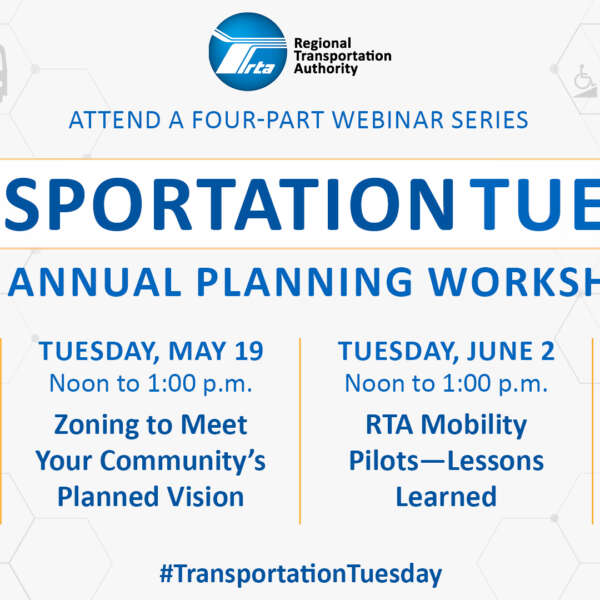Getting to the Bus or Train: A “Lot” More Than You Think
August 18, 2017
August 18, 2017

At the RTA, we think it’s time to talk about the 4 letter word of public transportation: CARS. Yes, of course, in a perfect world, we’d all be able to walk or ride (think 2 wheels not 4) to a transit stop for our daily commute or just to get around our region. But, at the RTA, we know that it’s not always possible for people to only commute solely by train or bus. A good amount of commuters, especially in the suburbs, need to drive to a transit stop and that’s where park-and-ride facilities can meet a need. These facilities allow people to drive to a transit station, park their car for the day and ride the train for their commute. It’s more efficient and economical than commuting only by car.
Park-and-ride facilities located near public transit provide numerous benefits to communities and transit agencies. These include access to transit as an alternative to driving alone, increased transit usage in low-density areas, convenient meeting points for carpools, reduced vehicle miles and emissions, and of course, increased transit ridership.
So if a transit agency or municipality wants to build a park-and-ride facility, all they have to do is pave some concrete to create space for cars, right?
Wrong.
A lot more (no pun intended) than you may think goes into planning, building and managing park-and-ride facilities. The traveling public’s actual trips vary greatly. Some customers incorporate biking into their trips, while others carpool. Some commuters do not park but are dropped off. The facilities themselves range from small surface lots to multilevel parking structures in TODs, and have to accommodate various buses and trains.
Since the process of building park-and-rides is complex, and of interest nationally, the Transportation Cooperative Research Board (TCRB) – an arm of the National Academies of Science, Engineering and Medicine -- worked to create the Decision-Making Toolbox to Plan and Manage Park-and-Ride Facilities for Public Transportation: Guidebook on Planning and Managing Park-and-Ride.
The RTA’s Peter Fahrenwald, Manager of Strategic & Corridor Planning, was nominated to serve on the TCRP panel which provided technical guidance and counsel to direct the research and analysis for the creation of this guidebook.
The Guidebook is a comprehensive resource for public transit agencies, municipalities and others interested in better planning and management of park-and-ride facilities. It includes a survey of best practices by agencies across North America and is a valuable technical resource for cities that are building transit networks, as well as more established agencies to better manage their current park-and-rides.
So if you park your car or bike at a park-and-ride facility, take a look around. There’s more to it than just a parking lot.
Subscribe to our Newsletter
Related Articles
 RTA celebrates 30 years of the Americans with Disabilities Act
RTA celebrates 30 years of the Americans with Disabilities Act
This month the RTA is celebrating the 30th anniversary of the Americans with Disabilities Act (ADA). The ADA transformed society and provided opportunities f...
July 29, 2020 Take a survey to help improve mobility options for older adults and people with disabilities
Take a survey to help improve mobility options for older adults and people with disabilities
Do you or someone you know face transportation challenges? The Regional Transportation Authority (RTA) wants to hear from you about transportation issues and...
May 7, 2020 Transportation Tuesday Webinar Series: Attend the 2020 RTA Annual Planning Workshop Virtually
Transportation Tuesday Webinar Series: Attend the 2020 RTA Annual Planning Workshop Virtually
The RTA is launching a four-part webinar series in place of the Annual Planning Workshop due to the ongoing COVID-19 pandemic. The free, virtual sessions wil...
April 17, 2020 Announcing the 2020 Access to Transit Program Call for Projects for Small-Scale Capital Projects
Announcing the 2020 Access to Transit Program Call for Projects for Small-Scale Capital Projects
We are excited to announce that the call for projects for the RTA Access to Transit Program is now open. The RTA launched the Access to Transit program in 2...
March 13, 2020 Happy International Women’s Day and Women’s History Month from the RTA
Happy International Women’s Day and Women’s History Month from the RTA
Each year the RTA celebrates Women’s History Month in March to recognize the women who work at, and ride, CTA, Metra, and Pace every day. The celebration coi...
March 8, 2020 How's Your Ride? Take This Survey
How's Your Ride? Take This Survey
We’d like to hear your thoughts about public transit! The RTA is sponsoring a system-wide customer satisfaction survey and would like your feedback about yo...
March 2, 2020